Abstract
A large portion of current epidemiologic research is based on methodologic individualism: the notion that the distribution of health and disease in populations can be explained exclusively in terms of the characteristics of individuals. The present paper discusses the need to include group- or macro-level variables in epidemiologic studies, thus incorporating multiple levels of determination in the study of health outcomes. These types of analyses, which have been called contextual or multi-level analyses, challenge epidemiologists to develop theoretical models of disease causation that extend across levels and explain how group-level and individual-level variables interact in shaping health and disease. They also raise a series of methodological issues, including the need to select the appropriate contextual unit and contextual variables, to correctly specify the individual-level model, and, in some cases, to account for residual correlation between individuals within contexts. Despite its complexities, multilevel analysis holds potential for reemphasizing the role of macro-level variables in shaping health and disease in populations.
Full text
PDF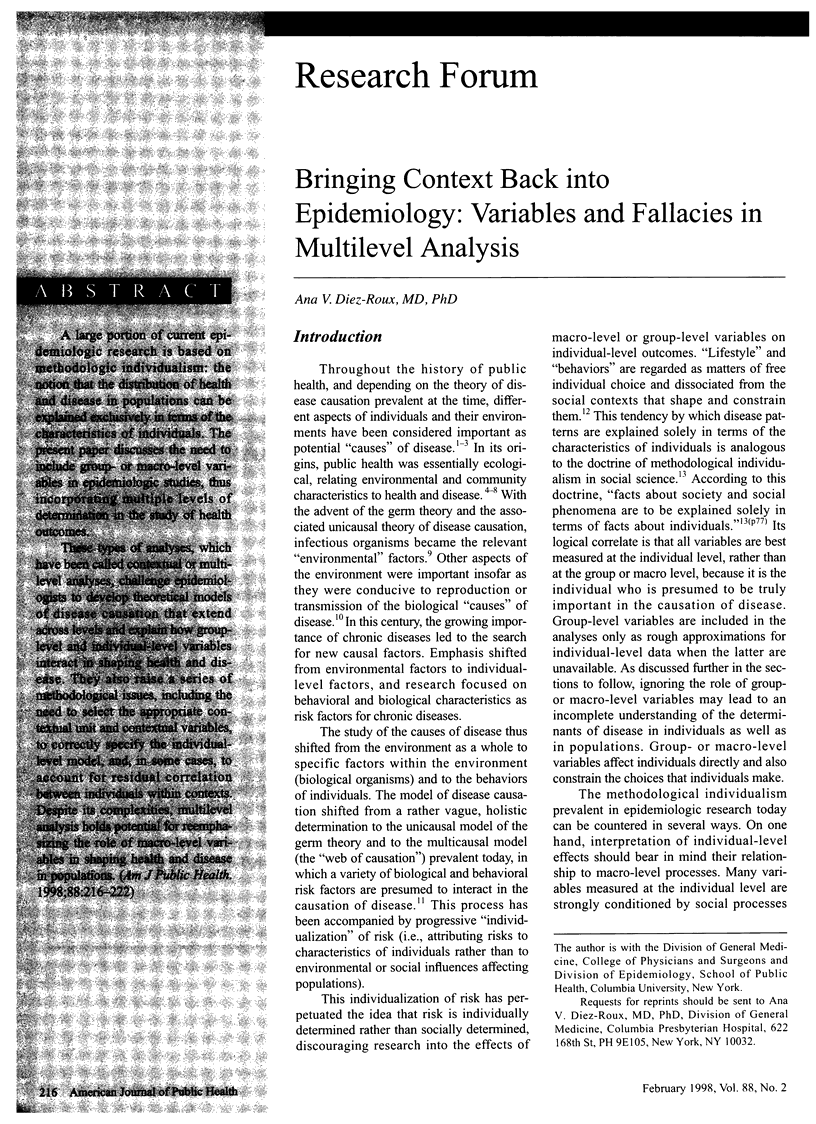
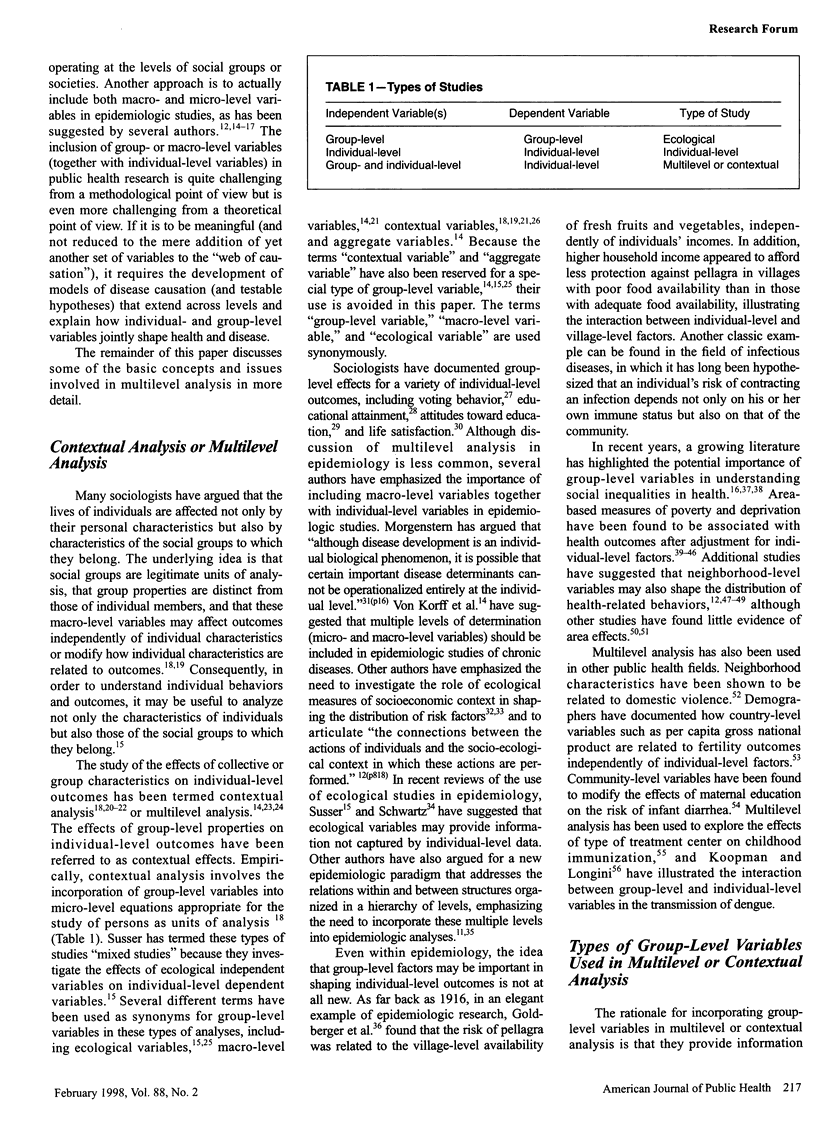
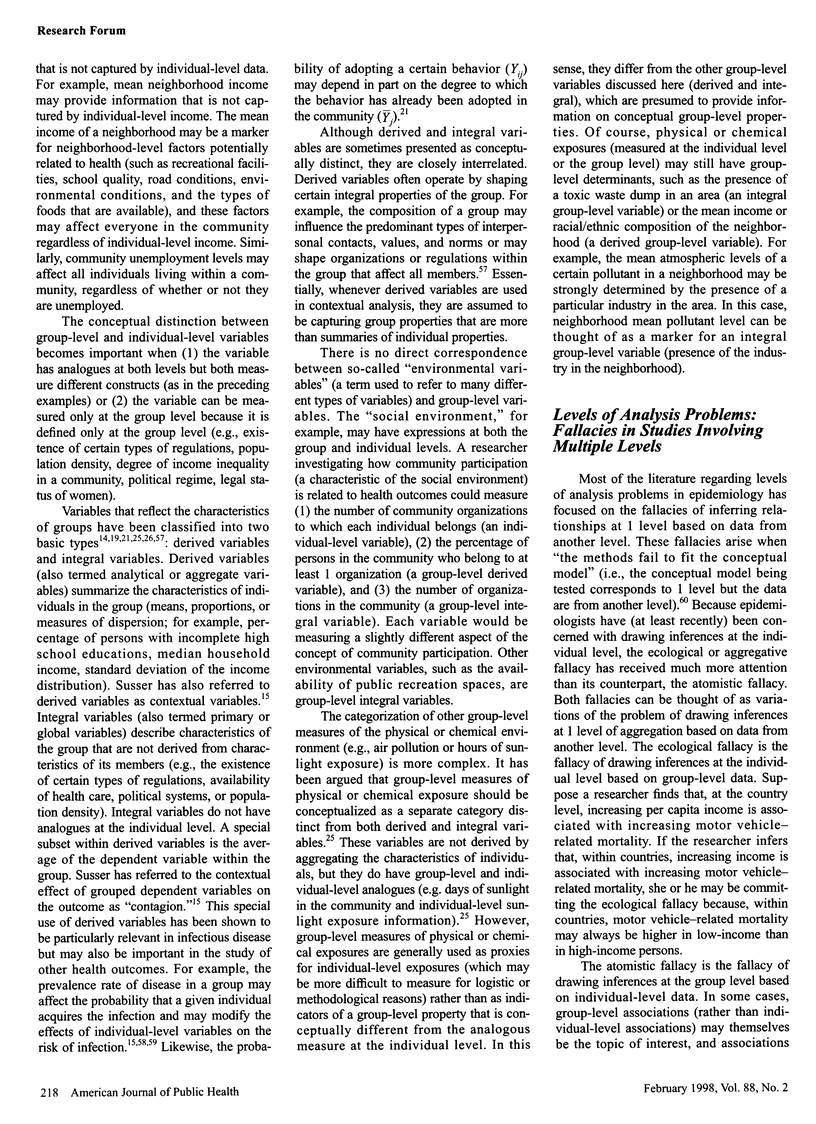
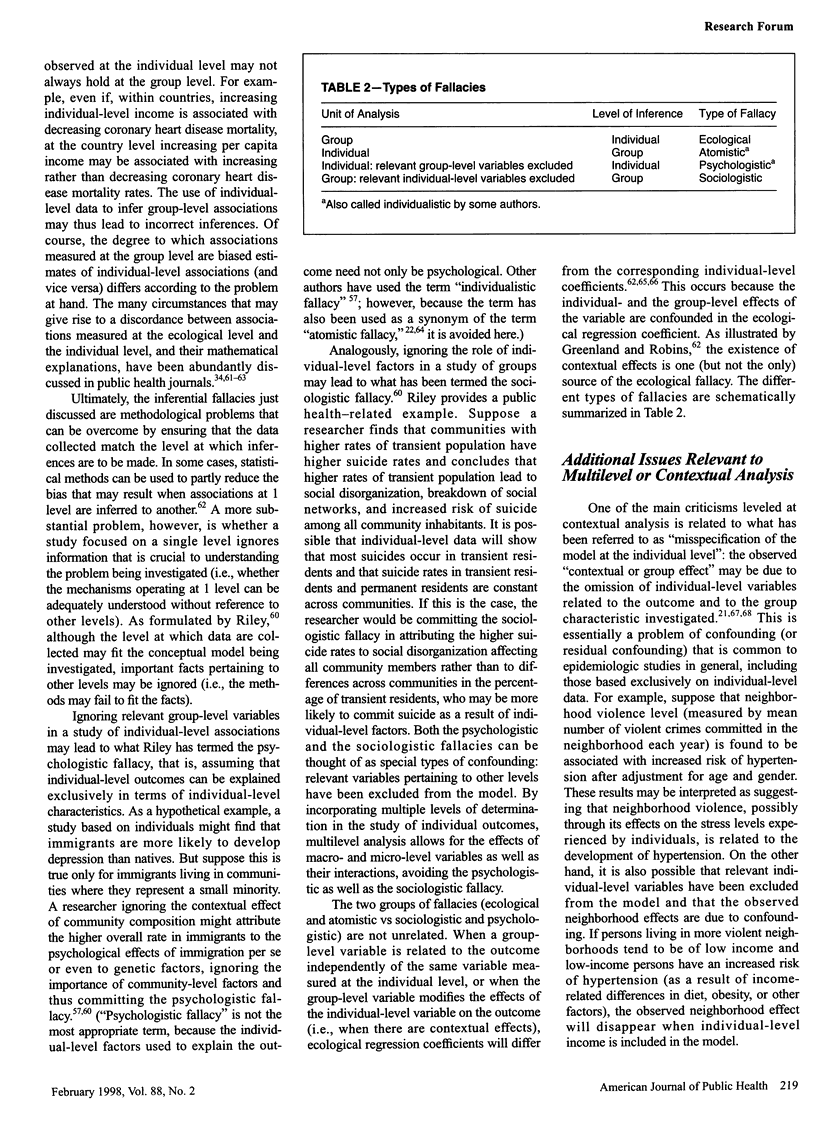
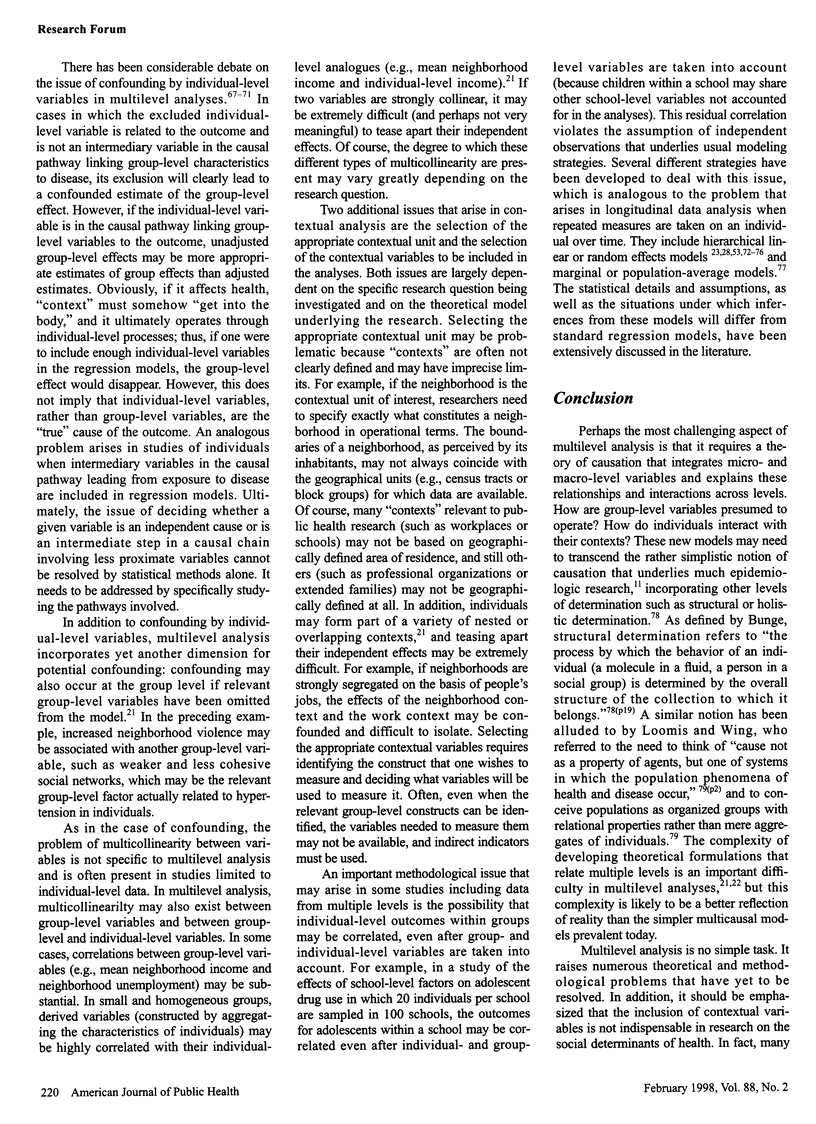


Selected References
These references are in PubMed. This may not be the complete list of references from this article.
- Anderson R. T., Sorlie P., Backlund E., Johnson N., Kaplan G. A. Mortality effects of community socioeconomic status. Epidemiology. 1997 Jan;8(1):42–47. doi: 10.1097/00001648-199701000-00007. [DOI] [PubMed] [Google Scholar]
- CASSEL J. SOCIAL SCIENCE THEORY AS A SOURCE OF HYPOTHESES IN EPIDEMIOLOGICAL RESEARCH. Am J Public Health Nations Health. 1964 Sep;54:1482–1488. doi: 10.2105/ajph.54.9.1482. [DOI] [PMC free article] [PubMed] [Google Scholar]
- Carstairs V., Morris R. Deprivation and mortality: an alternative to social class? Community Med. 1989 Aug;11(3):210–219. doi: 10.1093/oxfordjournals.pubmed.a042469. [DOI] [PubMed] [Google Scholar]
- Carstairs V., Morris R. Deprivation: explaining differences in mortality between Scotland and England and Wales. BMJ. 1989 Oct 7;299(6704):886–889. doi: 10.1136/bmj.299.6704.886. [DOI] [PMC free article] [PubMed] [Google Scholar]
- Dargent-Molina P., James S. A., Strogatz D. S., Savitz D. A. Association between maternal education and infant diarrhea in different household and community environments of Cebu, Philippines. Soc Sci Med. 1994 Jan;38(2):343–350. doi: 10.1016/0277-9536(94)90404-9. [DOI] [PubMed] [Google Scholar]
- Diehr P., Koepsell T., Cheadle A., Psaty B. M., Wagner E., Curry S. Do communities differ in health behaviors? J Clin Epidemiol. 1993 Oct;46(10):1141–1149. doi: 10.1016/0895-4356(93)90113-f. [DOI] [PubMed] [Google Scholar]
- Duncan C., Jones K., Moon G. Do places matter? A multi-level analysis of regional variations in health-related behaviour in Britain. Soc Sci Med. 1993 Sep;37(6):725–733. doi: 10.1016/0277-9536(93)90366-c. [DOI] [PubMed] [Google Scholar]
- Duncan C., Jones K., Moon G. Health-related behaviour in context: a multilevel modelling approach. Soc Sci Med. 1996 Mar;42(6):817–830. doi: 10.1016/0277-9536(95)00181-6. [DOI] [PubMed] [Google Scholar]
- Duncan C., Jones K., Moon G. Psychiatric morbidity: a multilevel approach to regional variations in the UK. J Epidemiol Community Health. 1995 Jun;49(3):290–295. doi: 10.1136/jech.49.3.290. [DOI] [PMC free article] [PubMed] [Google Scholar]
- Entwisle B., Mason W. M., Hermalin A. I. The multilevel dependence of contraceptive use on socioeconomic development and family planning program strength. Demography. 1986 May;23(2):199–216. [PubMed] [Google Scholar]
- Fox A. J., Jones D. R., Goldblatt P. O. Approaches to studying the effect of socio-economic circumstances on geographic differences in mortality in England and Wales. Br Med Bull. 1984 Oct;40(4):309–314. doi: 10.1093/oxfordjournals.bmb.a071996. [DOI] [PubMed] [Google Scholar]
- Greenland S., Morgenstern H. Ecological bias, confounding, and effect modification. Int J Epidemiol. 1989 Mar;18(1):269–274. doi: 10.1093/ije/18.1.269. [DOI] [PubMed] [Google Scholar]
- Greenland S., Robins J. Invited commentary: ecologic studies--biases, misconceptions, and counterexamples. Am J Epidemiol. 1994 Apr 15;139(8):747–760. doi: 10.1093/oxfordjournals.aje.a117069. [DOI] [PubMed] [Google Scholar]
- Haan M., Kaplan G. A., Camacho T. Poverty and health. Prospective evidence from the Alameda County Study. Am J Epidemiol. 1987 Jun;125(6):989–998. doi: 10.1093/oxfordjournals.aje.a114637. [DOI] [PubMed] [Google Scholar]
- Halloran M. E., Struchiner C. J. Study designs for dependent happenings. Epidemiology. 1991 Sep;2(5):331–338. doi: 10.1097/00001648-199109000-00004. [DOI] [PubMed] [Google Scholar]
- Jones K., Moon G., Clegg A. Ecological and individual effects in childhood immunisation uptake: a multi-level approach. Soc Sci Med. 1991;33(4):501–508. doi: 10.1016/0277-9536(91)90332-7. [DOI] [PubMed] [Google Scholar]
- Kaplan G. A., Keil J. E. Socioeconomic factors and cardiovascular disease: a review of the literature. Circulation. 1993 Oct;88(4 Pt 1):1973–1998. doi: 10.1161/01.cir.88.4.1973. [DOI] [PubMed] [Google Scholar]
- Koopman J. S., Longini I. M., Jr, Jacquez J. A., Simon C. P., Ostrow D. G., Martin W. R., Woodcock D. M. Assessing risk factors for transmission of infection. Am J Epidemiol. 1991 Jun 15;133(12):1199–1209. doi: 10.1093/oxfordjournals.aje.a115832. [DOI] [PubMed] [Google Scholar]
- Koopman J. S., Longini I. M., Jr The ecological effects of individual exposures and nonlinear disease dynamics in populations. Am J Public Health. 1994 May;84(5):836–842. doi: 10.2105/ajph.84.5.836. [DOI] [PMC free article] [PubMed] [Google Scholar]
- Krieger N. Epidemiology and the web of causation: has anyone seen the spider? Soc Sci Med. 1994 Oct;39(7):887–903. doi: 10.1016/0277-9536(94)90202-x. [DOI] [PubMed] [Google Scholar]
- Krieger N. Overcoming the absence of socioeconomic data in medical records: validation and application of a census-based methodology. Am J Public Health. 1992 May;82(5):703–710. doi: 10.2105/ajph.82.5.703. [DOI] [PMC free article] [PubMed] [Google Scholar]
- Krieger N., Rowley D. L., Herman A. A., Avery B., Phillips M. T. Racism, sexism, and social class: implications for studies of health, disease, and well-being. Am J Prev Med. 1993 Nov-Dec;9(6 Suppl):82–122. [PubMed] [Google Scholar]
- Krieger N. Women and social class: a methodological study comparing individual, household, and census measures as predictors of black/white differences in reproductive history. J Epidemiol Community Health. 1991 Mar;45(1):35–42. doi: 10.1136/jech.45.1.35. [DOI] [PMC free article] [PubMed] [Google Scholar]
- Loomis D., Wing S. Is molecular epidemiology a germ theory for the end of the twentieth century? Int J Epidemiol. 1990 Mar;19(1):1–3. doi: 10.1093/ije/19.1.1. [DOI] [PubMed] [Google Scholar]
- Morgan M., Chinn S. ACORN group, social class, and child health. J Epidemiol Community Health. 1983 Sep;37(3):196–203. doi: 10.1136/jech.37.3.196. [DOI] [PMC free article] [PubMed] [Google Scholar]
- Morgenstern H. Ecologic studies in epidemiology: concepts, principles, and methods. Annu Rev Public Health. 1995;16:61–81. doi: 10.1146/annurev.pu.16.050195.000425. [DOI] [PubMed] [Google Scholar]
- O'Campo P., Gielen A. C., Faden R. R., Xue X., Kass N., Wang M. C. Violence by male partners against women during the childbearing year: a contextual analysis. Am J Public Health. 1995 Aug;85(8 Pt 1):1092–1097. doi: 10.2105/ajph.85.8_pt_1.1092. [DOI] [PMC free article] [PubMed] [Google Scholar]
- Pearce N. Traditional epidemiology, modern epidemiology, and public health. Am J Public Health. 1996 May;86(5):678–683. doi: 10.2105/ajph.86.5.678. [DOI] [PMC free article] [PubMed] [Google Scholar]
- Piantadosi S., Byar D. P., Green S. B. The ecological fallacy. Am J Epidemiol. 1988 May;127(5):893–904. doi: 10.1093/oxfordjournals.aje.a114892. [DOI] [PubMed] [Google Scholar]
- Public Health Weekly Reports for NOVEMBER 12, 1920. Public Health Rep. 1920 Nov 12;35(46):2673–2761. [PMC free article] [PubMed] [Google Scholar]
- Schwartz S. The fallacy of the ecological fallacy: the potential misuse of a concept and the consequences. Am J Public Health. 1994 May;84(5):819–824. doi: 10.2105/ajph.84.5.819. [DOI] [PMC free article] [PubMed] [Google Scholar]
- Susser M., Susser E. Choosing a future for epidemiology: I. Eras and paradigms. Am J Public Health. 1996 May;86(5):668–673. doi: 10.2105/ajph.86.5.668. [DOI] [PMC free article] [PubMed] [Google Scholar]
- Susser M., Susser E. Choosing a future for epidemiology: II. From black box to Chinese boxes and eco-epidemiology. Am J Public Health. 1996 May;86(5):674–677. doi: 10.2105/ajph.86.5.674. [DOI] [PMC free article] [PubMed] [Google Scholar]
- Susser M. The logic in ecological: I. The logic of analysis. Am J Public Health. 1994 May;84(5):825–829. doi: 10.2105/ajph.84.5.825. [DOI] [PMC free article] [PubMed] [Google Scholar]
- Taylor R., Rieger A. Medicine as social science: Rudolf Virchow on the typhus epidemic in Upper Silesia. Int J Health Serv. 1985;15(4):547–559. doi: 10.2190/XX9V-ACD4-KUXD-C0E5. [DOI] [PubMed] [Google Scholar]
- Von Korff M., Koepsell T., Curry S., Diehr P. Multi-level analysis in epidemiologic research on health behaviors and outcomes. Am J Epidemiol. 1992 May 15;135(10):1077–1082. doi: 10.1093/oxfordjournals.aje.a116207. [DOI] [PubMed] [Google Scholar]
- Wing S., Barnett E., Casper M., Tyroler H. A. Geographic and socioeconomic variation in the onset of decline of coronary heart disease mortality in white women. Am J Public Health. 1992 Feb;82(2):204–209. doi: 10.2105/ajph.82.2.204. [DOI] [PMC free article] [PubMed] [Google Scholar]
- Wing S., Casper M., Riggan W., Hayes C., Tyroler H. A. Socioenvironmental characteristics associated with the onset of decline of ischemic heart disease mortality in the United States. Am J Public Health. 1988 Aug;78(8):923–926. doi: 10.2105/ajph.78.8.923. [DOI] [PMC free article] [PubMed] [Google Scholar]
- Zeger S. L., Liang K. Y., Albert P. S. Models for longitudinal data: a generalized estimating equation approach. Biometrics. 1988 Dec;44(4):1049–1060. [PubMed] [Google Scholar]


